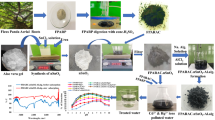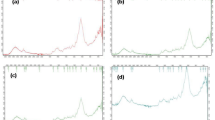Abstract
Bio-adsorbents derived from Sesbania grandiflora (SGSP/SGSAC) and Amorphophallus paeoniifolius (APSP/APSAC) plants are investigated for their ability to remove nitrite from polluted water. Different extraction conditions have been investigated and optimized for the maximum nitrite removal. Adsorption capacities are found to be 44.5 mg/g for SGSP, 57.5 mg/g for SGSAC, 40.0 mg/g for APSP and 65.5 mg/g for APSAC. Thermodynamic parameters are evaluated. High values of ΔH° for SGSAC (50.872 kJ/mole) and APSAC (67.907 kJ/mole) indicate ion exchange mode of sorption. Spontaneous and endothermic nature of sorption is indicated by negative ΔG values. Positive values of ΔS emphasizes the disorder at solid/liquid interface. The adsorption follows Langmuir isotherm for all the four sorbents, indicating formation of monolayer of nitrite ‘onto’ the surface of sorbents and uniform distribution active sites. Pseudo second-order kinetics explains well the kinetics of adsorption and this reflects that the adsorption is through exchange of electrons or sharing of electrons between nitrite and functional groups sorbents. The developed sorbents are applied effectively for nitrite removal from polluted lake real water samples. The merit of the present investigation is that simple, effective and easily available plant-based bio-materials are identified for the removal of toxic nitrites from water.
Graphical abstract











Similar content being viewed by others
References
Abuzaid NS, Al-Hamouz Z, Bukhari AA, Essa MH (1999) Electrochemical treatment of nitrite using stainless steel electrodes. Water Air Soil Pollut 109:429–442
Adamson AW, Gast AP (1997) Physical chemistry of surfaces, 6th edn. Wiley-Interscience, New York
Afkhami A, Madrakian T, Karimi Z (2007) The effect of acid treatment of carbon cloth on the adsorption of nitrite and nitrate ions. Journal of Hazardous Materials 144(1–2):427–431
APHA (1998) Standard methods for the examination of water and wastewater, 20th edn. American Public Health Association, Washington, DC
Awual MR, Hasan MM (2019) A ligand based innovative composite material for selective lead(II) capturing from wastewater. of Molecular Liquids 294:111679
Awual MR, Shenashen MA, Yaita T, Shiwaku H, Jyo H (2012) Efficient arsenic(V) removal from water by ligand exchange fibrous adsorbent. Water Res 46:5541–5550
Awual MR (2015) A novel facial composite adsorbent for enhanced copper(II) detection and removal from wastewater. Chem Eng J 266:368–375
Awual MR, Hasan MM, Asiri AM, Rahman MM (2019) Cleaning the arsenic(V) contaminated water for safe-guarding the public health using novel composite material. Composites Part B 171:294–301
Awual MR, Hasan MM, Asiri AM, Rahman MM, Alharthi NH (2019) Assessment of enhanced nitrite removal and monitoring using ligand modified stable conjugate materials. Chem Eng J 363:64–72
Awual MR, Hasan MM, Islam A, Rahman MM, Asiri AM, Khaleque MA, Sheikh MC (2019) Introducing an amine functionalized novel conjugate material for toxic nitrite detection and adsorption from wastewater. J of Clean Prod 228:778–785
Awual MR, Hasan MM, Islam A, Rahman MM, Asiri AM, Khaleque MA, Sheikh MC (2019) Offering an innovative composited material for effective lead(II) monitoring and removal from polluted water. J of Clean Prod 231:214–223
Awual R, Hasan M, Iqbal J, Islam A, Islam MA, Khandaker S, Asiri AM, Rahman MM (2019) Ligand based sustainable composite material for sensitive nickel(II) capturing in aqueous media. J of Environ Cheml Engs. https://doi.org/10.1016/j.jece.2019.103591
Awual MR, Yaita T, Kobayashi T, Shiwaku H, Suzuki S (2020) Improving cesium removal to clean up the contaminated water using modified conjugate material Journal of Environmental. Chem Eng 8:103684
Awual MR, Hasan MM, Iqbal J, Islam A, Islam MA, Asiri AM, Rahman (2020) Naked-eye lead II capturing from contaminated water using innovative large pore facial composite materials. Microchem J 154:104585
Biftu WK, Sunetha M, Ravindhranath K. 2021. Zirconium-alginate beads doped with H2SO4-activated carbon derived from leaves of Magnoliaceae plant as an effective adsorbent for the removal of chromate. Biomass Conversion and Biorefinery, 1-16. https://doi.org/10.1007/s13399-021-01568-w
De D, Kalu EE, Tarjan PP, Englehardt JD (2004) Kinetic studies of the electrochemical treatment of nitrate and nitrite ions on iridium-modified carbon fibre electrodes. Chem Eng Technol 27:56–64
Diaz V, Ibanez R, Gomez P, Urtiaga AM, Ortiz I (2010) Kinetics of electro-oxidation of ammonia-N nitrites from a recirculating aquaculture saline water system using BDD anodes. Water Res 45(125):134
Emamjomeh MM, Sivakumar M (2009) Review of pollutants removed by electrocoagulation and electrocoagulation/flotation processes. J Environ Manage 90(5):1663–1679
FAO/WHO, 2002. Evaluation of certain food additives. Fifty-ninth report of the joint FAO/WHO expert committee on food additives. Geneva, World Health Organization.
FAO/WHO (2003) Nitrate (potential endogenous formation of N-nitroso compounds). In: Safety evaluation of certain food additives and contaminants. Geneva, World Health Organization, Joint FAO/WHO expert committee on food additives (WHO food additives series no. 50; http://www.inchem.org/documents/jecfa/jecmono/v50je06.htm)
Foley J, De Haas D, Yuan Z, Lant P (2010) Nitrous oxide generation in full-scale biological nutrient removal wastewater treatment plants. Water Res 44:831–844
Freundlich HM (1906) Over the adsorption in solution. J Phys Chem 57(385471):1100–7
Gierak, A., Łazarska, I., 2017. Adsorption of nitrate, nitrite, and ammonium ions on carbon adsorbents. Adsorption science & technology, 1–7, 15th Ukrainian-Polish symposium, https://doi.org/10.1177/0263617417708085.
Hall KR, Eagleton LC, Acrivos A, Vermeulen T (1966) Pore and solid-diffusion kinetics in fixed-bed adsorption under constant-pattern conditions. Industrial & Eng Chem Fund 5(2):212–23. https://doi.org/10.1021/i160018a011
Hanafi HA, Azeema SMA (2016) Removal of nitrate and nitrite anions from wastewater using activated carbon derived from rice straw. J Environ Anal Toxicol 6:346. https://doi.org/10.4172/2161-0525.1000346
Hiba Nassar IN (2012) Nitrate and nitrite ion removal from aqueous solutions by activated carbon prepared from olive stones. Thesis, An-Najah National University, Palestine, M. Sc
Ho YS, McKay G (1999) Pseudo-second order model for sorption processes. Process Biochem 34:451–465
Hu Q, Westerhoff P, Vermaas W (2000) Removal of nitrate from groundwater by cyanobacteria: quantitative assessment of factors influencing nitrate uptake. Appl environ Microbiol 66:133–139
Kaman S, Bhuwan C (2015) Adsorption behaviours of phenols onto high specific area activated carbon derived from Trapa bispinosa. Indian J of Chem Technol 22:11–19
Kamel RM, Shahat A, Hegazy WH, Khodier EM, Awual MR (2019) Efficient toxic nitrite monitoring and removal from aqueous media with ligand based conjugate materials. J of Molecular Liquids 285:20–26
Knaebel KS (2003) Adsorbent selection, Adsorption Research, Inc., Dublin, Ohio, 43016, 1–23; https://userpages.umbc.edu/~dfrey1/ench445/AdsorbentSel1B.pdf
Lagergren, S. (1898). About the theory of so-called adsorption of soluble substances. Kungliga Svenska, Vetenskapsakademiens. Handlingar, 24(4), 1–39.
Langmuir I (1918) The adsorption of gases on plane surfaces of glass, mica and platinum. J Am Chem society 40(9):1361–403. https://doi.org/10.1021/ja02242a004
Lin SH, Wu CL (1996) Removal of nitrogenous compounds from aqueous solution by ozonation and ion exchange. Water Res 30(8):1851–1857
Lin S, Wu C (1996) Electrochemical removal of nitrite and ammonia for aquaculture. Water Res 30:715–721
Metcalf Eddy (2003) Wastewater engineering: treatment of reuse, 4th edn. McGraw Hill Co., New York
Mohan KGV, Babu AN, Kalpana K, Ravindhranath K (2019) Removal of chromium (VI) from water using adsorbent derived from spent coffee grounds. Int J of Environ Sci Technol 16(1):101–112
Naga, B. A., Kalpana, K., Ravindhranath, K., 2017. Removal of lead from water using calcium alginate beads doped with hydrazine sulphate-activated red mud as adsorbent. Journal of Analytical Methods in Chemistry. Article ID 4650594, https://doi.org/10.1155/2017/4650594.
Naga BA, Mohan MGV, Kalpana K, Ravindhranath K (2018) Removal of fluoride from water using H2O2-treated fine red mud doped in Zn-alginate beads as adsorbent. J of Environl Chem Eng 6(1):906–916
Ogata F, Nagai N, Kariya Y, Nagahashi E, Kobavashi Y, Nakumura T, Kawasaki N (2018) Adsorption of nitrite and nitrate ions from an aqueous solution by Fe–Mg-type hydrotalcites at different molar ratios. Chem Pharm Bull 66(4):458–465
Ozturk TN, Kose E (2008) A kinetic study of nitrite adsorption onto sepiolite and powdered activated carbon. Desalination 223:174–179
Poxton MG, Allhouse SB (1982) Water quality criteria for marine fisheries. Aquaculture Eng 1:153–191
Ravulapalli S, Ravindhranath K (2019) Novel adsorbents possessing cumulative sorption nature evoked from Al2O3 nanoflakes, C. urens seeds active carbon and calcium alginate beads for defluoridation studies. J of the Taiwan Institute of Chem Eng 101:50–63
Shahat A, Hassan HMA, Azzazy HME, Hosni M, Awual MR (2017) Novel nano-conjugate materials for effective arsenic(V) and phosphate capturing in aqueous media. Chem Eng J. https://doi.org/10.1016/j.cej.2017.08.037
Shahat, A., Hassan, H.M.A., El-Shahat, M. F., El-Shahawy, O., Awual, M.R., 2017b. Visual nickel(II) ions treatment in petroleum samples using a mesoporous composite adsorbent, Chemical Engineering Journal (2017), https://doi.org/10.1016/j.cej.2017.10.105
SnehaLatha P, Biftu WK, Suneetha M, Ravindhranath K (2021) Effective adsorbents based on nano mixed (Al-Fe-Zr) oxide synthesised by new green methods: for the simultaneous extraction of phosphate and chromate from contaminated water. Int J of Environ Analyt Chem. https://doi.org/10.1080/03067319.2021.1927004
Sujitha R, Ravindhranath K (2017) Defluoridation studies using active carbon derived from the barks of Ficus racemosa plant. J of Fluorine Chem 193:58–66
Sun CC, Chou CC (2000) Electrochemically promoted photocatalytic oxidation of nitrite ion by using rutile form of TiO2/Ti electrode. J Mol Catal A: Chem 151:133–145
Sun., C. C., Chou, T. C., (1999) Kinetics of anodic oxidation of nitrite ion using in situ electrogenerated HClO in a NaCl aqueous solution. Ind Eng Chem Res 38:4545–4551
Suneetha M, Sundar BS, Ravindhranath K (2015) Removal of fluoride from polluted waters using active carbon derived from barks of Vitex negundo plant. J of Analyt Sc and Technol 6:15
Suneetha MB, Syama S, Rabindranath K (2015) De-fluoridation of waters using low-cost HNO3 activated carbon derived from stems of Senna occidentalis plant. Int J of Environ Technol and Manage 18(5/6):420–447
Suneetha M, Ravindhranath K (2012) Removal of nitrites from waste waters using ashes of some herbal plants as bio-sorbents. Res J Sci and Technol 4(3):115–121
Suneetha M, Ravindhranath K (2012) Removal of nitrite from polluted waters using bio sorbents derived from powders of leaves barks or stems of some herbal plants International. J Chem Environ and Pharm Res 3(1):24–34
Suneetha M, Ravindhranath K (2013) Extraction of Nitrites from waste water using bio sorbents derived from Eichhornia plant. Int J Res in Pharm and Chem 3(1):57–63
Suneetha M, Ravindhranath K (2014) Extractability of nitrites from polluted waters using bio-sorbents derived from leaves, barks or stems of some herbal plants. J of Chem and Pharm Res 6(8):408–420
Suneetha M, Ravindhranath K (2016) Extraction of nitrite ions from polluted waters using ash of Tridax procumbens leaves as adsorbent. Der Pharmacia Lettre 8(6):119–128
Suneetha M, Ravindhranath K (2017) Adsorption of nitrite ions onto the bio sorbents derived from Azadirachta indica plant Asian. J of Water Environ Pollution 14(2):71–79
Suneetha M, Ravindhranath K (2018) Removal of nitrites from waste waters using adsorbents derived from Phyllanthus neruri plant. Indian J of Chem Technol 25(4):345–352
Tchobanoglous, G., 1979. Wastewater engineering: treatment disposal reuse. McGraw-Hill, Inc., 2nd edn., New York, 88.
Trivedy RK (1995) Pollution management in industries. Environmental publications, 2nd edn. Karad, India
U.S. department of health and human services, Public Health Service Agency for Toxic Substances and Disease Registry (2017) Toxicological profile for nitrate and nitrite. https://www.atsdr.cdc.gov/toxprofiles/tp204.pdf
Virkutyte J, Rokhina E, Jegatheesan V (2010) Optimisation of electro-Fenton denitrification of a model wastewater using a response surface methodology. Bioresour Technol 101:1440–1446
Vogel, A. I., 1961. A text book of quantitative inorganic analysis including elementary instrument analysis. 3rd Ed. ELBS.
Acknowledgements
The authors thank the authorities of K L University for providing the necessary facilities for this research work.
Author information
Authors and Affiliations
Corresponding author
Additional information
Publisher’s note
Springer Nature remains neutral with regard to jurisdictional claims in published maps and institutional affiliations.
Highlights
• Bio-adsorbents derived from stems of Sesbania grandiflora and Amorphophallus paeoniifolius plants are investigated as adsorbents for the removal of toxic nitrite ions.
• Extraction conditions are investigated and optimized for the maximum nitrite removal.
• Adsorption capacities are found to be very high for the stems as well as active carbons.
• Thermodynamic parameters are evaluated.
• The adsorption follows Langmuir isotherm for all the four sorbents
• Pseudo second-order kinetics explains well the kinetics of adsorption.
• The developed sorbents are applied effectively for nitrite removal from polluted lake water samples.
Rights and permissions
About this article
Cite this article
Babu, D.K., Ravindhranath, K. & Mekala, S. Simple effective new bio-adsorbents for the removal of highly toxic nitrite ions from wastewater. Biomass Conv. Bioref. 13, 9721–9733 (2023). https://doi.org/10.1007/s13399-021-01677-6
Received:
Revised:
Accepted:
Published:
Issue Date:
DOI: https://doi.org/10.1007/s13399-021-01677-6




